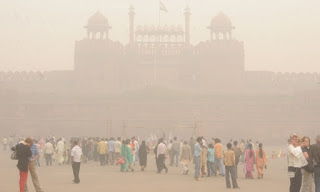Optimistically-inclined readers may want to skip this extensive, appalling report in yesterday's Guardian on the state of energy conversion in India. India is on the verge of being the world's most populous country. It will soon surpass the United States and rival China as the largest emitter of greenhouse gases. Under its powerful nationalist BJP government it intends to reinstitute 10% per year economic growth, powered mainly by domestically-produced dirty coal. And it makes no promises or apologies to the global climate movement.
One third of India's 1.3 billion inhabitants still lack electricity. Even with projected growth rates that are staggeringly ambitious--one new coal mine per month from now till 2020, says their coal minister--India will still emit less than a third of the greenhouse gases per capita in 2030 as will the US and China, according to their 'convergence' agreement to achieve something like parity. India's position is that eliminating poverty is its overwhelming priority--wealthier nations can address the climate problem. As Prime Minister Modi insists, India has a "right to growth," and it will make no international promises that infringe on that right.
India's environmental minister has also asserted that "clean air is our birthright," though the photo of Delhi, above, might call that into question. Nonetheless there are attempts to replace the oldest, dirtiest coal-burning plants--whose environmental consequences are truly nightmarish--with more modern cleaner ones. Requirements to reforest devastated mining sites are taking hold. Carbon capture technologies may be especially important in reducing India's impact on global atmospheric carbon.
India also has enormous potential for solar--solar intensity makes panels three times more productive there than in northern Europe--and a rapid increase in solar production, from 3 GW to 100 GW in the next 7 years, is also part of its national growth plan. The perfect correlation of seasonal needs--irrigation, cooling--with dry, sunny weather adds to the potential, as does the usefulness of rooftop solar in a country whose national infrastructure is underdeveloped as India's is. Nonetheless, given India's non-negotiable growth policies, the addition of solar to coal is a both/and, not an either/or proposition.
India's current refusal to make any international commitments, given its size and growth projections, threatens to derail the whole enterprise of the Paris COP21 conference. The coal it intends to mine and burn between now and 2040 would by itself exceed the 'carbon budget' the IPCC report considers permissible for restraining temperature rise to 2C. And yet India's government understands its vulnerability to climate change and environmental depredation--Delhi already has the world's worst air quality, and the environmental immiseration of whole regions is well-documented. Clearly this contradiction won't be resolved by the Paris meetings in December, but will a mechanism be put in place for steering India--and smaller less-developed countries with similar dilemmas--towards eventual resolutions? The acceleration of solar power and carbon capture may be the only hope to keep India's growth from pushing climate change into the catastrophic zone. Technical and financial assistance, forbearance, and solidarity--the Paris conference will need these in abundance if India, with its exceptional needs and demands, is to be brought gradually into the global consensus.

No comments:
Post a Comment